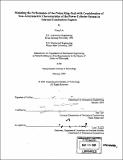| dc.contributor.advisor | Tian Tian. | en_US |
| dc.contributor.author | Liu, Liang, 1971- | en_US |
| dc.contributor.other | Massachusetts Institute of Technology. Dept. of Mechanical Engineering. | en_US |
| dc.date.accessioned | 2006-03-24T18:41:28Z | |
| dc.date.available | 2006-03-24T18:41:28Z | |
| dc.date.copyright | 2005 | en_US |
| dc.date.issued | 2005 | en_US |
| dc.identifier.uri | http://hdl.handle.net/1721.1/30336 | |
| dc.description | Thesis (Ph. D.)--Massachusetts Institute of Technology, Dept. of Mechanical Engineering, 2005. | en_US |
| dc.description | Includes bibliographical references (p. 139-143). | en_US |
| dc.description.abstract | The performance of the piston ring-pack is directly associated with the friction, oil consumption, wear, and blow-by in internal combustion engines. Because of non-axisymmetric characteristics of the power cylinder system, the performance of a ring varies along its circumference. Investigating these variations is of great interest for developing advanced ring-packs, but is out of the capabilities of the existing two-dimensional models. In this work, three separate but closely related numerical models were developed to study the performance of the piston ring-pack. The model for static analysis was developed to facilitate the design of piston rings. In this model, a finite beam element model is adopted with incorporation of a physics-based sub-model describing the interaction between the ring and the bore as well as the ring and the groove. A step-by-step approach is adopted to calculate the ring/bore and ring/groove conformability if the free shape of the ring is given. A method that can be used to determine the free shape as to achieve a specific tension distribution is also developed. Model results revealed the complex ring/bore and ring/groove interaction. A three-dimensional model for ring dynamics and blow-by gas flow was developed to address non-axisymmetric characteristics of the power cylinder system. In this model, the rings are discretized into straight beam elements. 3-D finite element analysis is employed to address the structural response of each ring to external loads. Physics-based sub-models are developed to simulate each ring's interactions with the piston groove and the liner. The gas flows driven by the pressure difference along both the axial and circumferential directions are modeled as well. | en_US |
| dc.description.abstract | (cont.) This model predicts the inter-ring gas pressure and 3-D displacements of the three rings at various circumferential locations. Model results show significant variations of the dynamic behavior along ring circumference. In the ring-pack lubrication model, an improved flow continuity algorithm is implemented in the ring/liner hydrodynamic lubrication, and proves to be very practicable. By coupling the ring/liner lubrication with the in-plane structural response of the ring, the lubrication along the entire ring circumference can be calculated. Model results show significant variations of lubrication along the circumference due to the non-axisymmetric characteristics of the power cylinder system. Bore distortion was found to have profound effects on oil transport along the liner. Particularly, it stimulates the occurrence of oil up-scraping by the top ring during compression stroke. Because the oil evaporation on the liner affects the liner oil film thickness, a sub-model for liner evaporation with consideration of multi-species oil is incorporated with the lubrication model. With consideration of oil transport along the liner, the prediction of evaporation is more precise. The combination of these models is a complete package for piston ring-pack analysis. It is computationally robust and efficient, and thus has appreciable practical value. | en_US |
| dc.description.statementofresponsibility | by Liang Liu. | en_US |
| dc.format.extent | 143 p. | en_US |
| dc.format.extent | 7159171 bytes | |
| dc.format.extent | 7178145 bytes | |
| dc.format.mimetype | application/pdf | |
| dc.format.mimetype | application/pdf | |
| dc.language.iso | eng | en_US |
| dc.publisher | Massachusetts Institute of Technology | en_US |
| dc.rights | M.I.T. theses are protected by copyright. They may be viewed from this source for any purpose, but reproduction or distribution in any format is prohibited without written permission. See provided URL for inquiries about permission. | en_US |
| dc.rights.uri | http://dspace.mit.edu/handle/1721.1/7582 | |
| dc.subject | Mechanical Engineering. | en_US |
| dc.title | Modeling the performance of the piston ring-pack with consideration of non-axisymmetric characteristics of the power cylinder system in internal combustion engines | en_US |
| dc.type | Thesis | en_US |
| dc.description.degree | Ph.D. | en_US |
| dc.contributor.department | Massachusetts Institute of Technology. Department of Mechanical Engineering | |
| dc.identifier.oclc | 61126273 | en_US |
